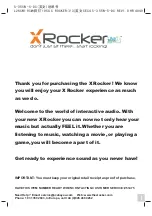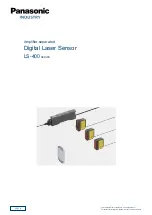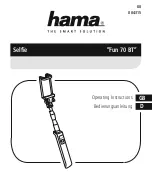
Speedkid
Speedkid
Subject to change without notice. – 12 | 2020 –
63
62
– 12 | 2020 – Subject to change without notice.
Utilisation
Utilisation
Checking the weight distribution and tow bar load
An optimum weight distribution is important for safe handling. The load’s centre of gravity should
always lie in the centre of the wheel axle. The tow bar load with which the tow bar lies on the
coupler must be neither too great nor too low in Trailer mode:
»
Tow bar load too great (> 8 kg): Too much load on the coupler.
»
Tow bar load too low (< 0 kg): The trailer could reduce the traction of the bike through lifting
and e.g. cause unwanted situations in curves.
»
Centre of gravity too far out: Loading on one side makes tipping over while cornering more likely.
Danger!
Distribute the load evenly across the width of the Speedkid. If you are only carrying
one child, the child must sit in the middle, see
„Middle sitting position (Speedkid2)“
on page 61
.
Check the support load before each journey with the vehicle. Support loads
outside the permitted range of 0 - 8 kg cause unintended driving behaviour.
Checking the tow bar load
Use bathroom scales, for example, to measure the tow bar load:
»
Load the Speedkid in the usual way and fasten the children in.
»
Do not connect the trailer to the bicycle yet.
»
Place the bathroom scales next to the tow bar.
»
Get onto the bathroom scales and note the weight displayed.
»
Lift the tow bar head pocket to the coupler height (approx. 35 cm).
»
The support load is the difference in weight between the current measured value and the one
you have previously memorized.
–
The weight
must be equal to or higher
than the measured value without the tow bar.
–
The weight
may be a maximum of 8 kg more
than the measured value without the tow bar.
Changing the tow bar load
Adjust the tow bar load by moving or reducing your baggage:
»
Tow bar load over 8 kg: Move luggage to the back.
»
Tow bar load less than 0 kg: Move luggage to the front.
Total weight too heavy
»
Reduce the baggage weight in the pouch for small items.
»
Reduce the baggage weight in the storage space.
»
Make sure that the loaded Speedkid1 weighs less than 50 kg.
»
Make sure that the loaded Speedkid2 weighs less than 60 kg.
Connecting the trailer to a bicycle
Danger!
Do not connect the
Speedkid
to a bicycle until the following conditions have been
fulfilled:
»
The trailer is fully loaded.
»
The children wear a bicycle helmet or use a head rest and are properly belted.
»
The buggy wheel has been removed.
»
The tow bar load has been checked and is within the permissible
range (0 – 8 kg).
»
Remove the retaining cotter pin from the tow bar
coupler pocket.
»
Push the tow bar onto the coupler of the bicycle so
that the cotter pin holes in the coupler and tow bar
couplet pocket are one above the other.
»
Insert the cotter pin into the hole and lock the cotter
pin fastening.
»
Check that the connection between the coupler and
the tow bar is secure.
»
Guide the tow bar’s retaining strap through the
braces of the rear wheel so that the trailer is securely
connected to the bicycle frame.
»
Fix the safety strap using the clamping buckle on the tow bar head. Make sure that it cannot
flutter into the spokes of the rear wheel while riding. If necessary, wrap the safety strap
several times around the bicycle frame and fix the end of the strap with the rubber ring on the
shaft of the tow bar.
Danger!
Always make sure that the safety strap is in place before using the stroller in trailer
mode. In addition, make sure that the safety strap cannot get into moving parts of
the pushchair.
Danger!
Always secure the tow bar to the bicycle frame with the retaining strap. This
ensures that the trailer will remain connected even if the tow bar becomes
detached from the coupler.
Irrespective, the coupler must always be properly mounted and the connection
to the tow bar must be secured with the locked cotter pin. Otherwise the tow
bar can be come detached and can be pushed into the rear wheel’s spokes
during braking.








































